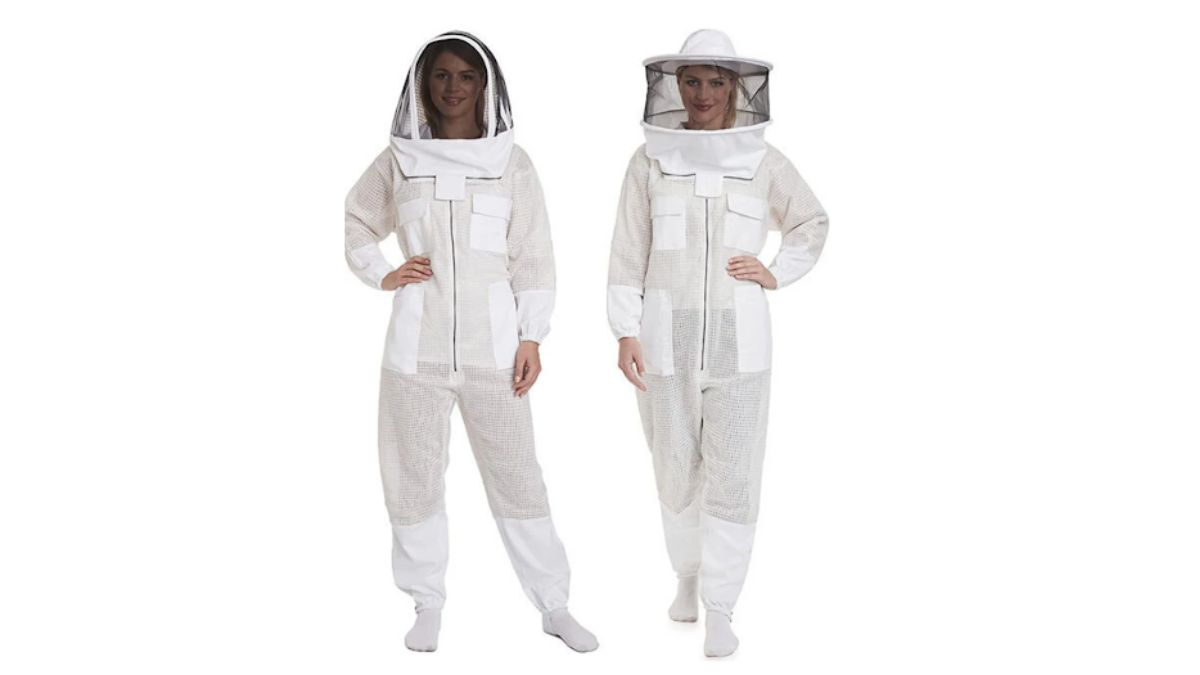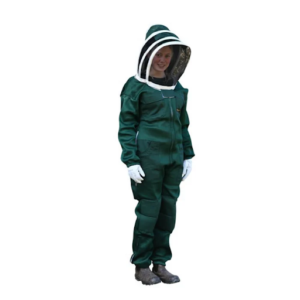BLOG
How Much Does a Bee Suit Cost for Beekeeping?

Beekeeping is a rewarding activity that offers more than just honey and beeswax—it allows you to play a role in supporting biodiversity and agricultural sustainability. However, one key to successful and safe beekeeping is proper protective gear, with the bee suit being the cornerstone of every beekeeper’s toolkit. A bee suit shields you from stings and provides the confidence to handle hives efficiently, ensuring that both you and the bees remain safe.
The big question is, how much does a bee suit cost for beekeeping? At Bebees Beekeeping Supply Companies, we pride ourselves on offering high-quality bee suits at remarkably affordable prices, ranging from $70 to $150. Whether you’re a beginner or a seasoned beekeeper, our suits deliver the perfect balance of safety, comfort, and affordability. Let’s dive into the details to understand the cost, features, and value of investing in a Bebees bee suit.
Understanding the Cost of a Bee Suit
The price of a bee suit varies based on factors like material, design, and additional features. At Bebees, we ensure that you get the best value, no matter your budget or experience level. Here’s a comprehensive breakdown of what you can expect within our price range:
1. Entry-Level Bee Suits: $70 to $90
Entry-level bee suits are designed for beginner beekeepers or hobbyists who perform occasional hive inspections. They offer fundamental protection at an economical price, making them ideal for those just starting their beekeeping journey.
Features:
Lightweight Materials: These suits are made from durable yet lightweight fabrics, such as basic polyester or cotton blends.
Integrated Veil: Includes a protective veil that covers the face and neck, ensuring safety during inspections.
Elastic Seals: Fitted with elastic cuffs and ankles to prevent bees from entering.
Simple Design: Streamlined to provide essential coverage without unnecessary bulk.
Best For: Casual beekeepers with one or two hives who need reliable, no-frills protection.
Advantages: Affordable, lightweight, and easy to use.
Limitations: Limited ventilation and durability; not suitable for prolonged use or extremely hot climates.
2. Mid-Range Bee Suits: $90 to $120
Mid-range bee suits offer a step up in quality and comfort, making them perfect for hobbyists or semi-professional beekeepers who work with hives more frequently. These suits are designed to provide enhanced durability and usability.
Features:
Ventilated Panels: Strategically placed mesh panels or breathable fabrics to ensure airflow, reducing discomfort during warm weather.
Detachable Veil: Zippered or Velcro veils for easy cleaning and convenience.
Reinforced Seams and Zippers: Sturdier construction to withstand frequent use.
Lightweight Durability: Balances comfort and protection for regular hive management.
Best For: Beekeepers managing multiple hives who need a suit that can handle moderate to frequent use.
Advantages: Combines affordability with improved features for added safety and comfort.
Limitations: May lack some of the advanced features found in premium suits, such as triple-layer protection.
3. Premium Bee Suits: $120 to $150
At the higher end of Bebees’ range, our premium bee suits offer professional-grade protection and advanced features typically found in much more expensive suits. These suits are built for serious beekeepers who require maximum safety and comfort during extended hive work.
Features:
Triple-Layer Protection: Designed with multi-layered fabrics or mesh for superior sting resistance and ventilation.
Integrated Accessories: Includes extras like gloves, boot covers, and spacious storage pockets for tools.
Enhanced Comfort: Elastic seals at wrists, ankles, and waists prevent bee entry while maintaining flexibility.
Extended Veil Designs: Provides broader coverage and increased visibility.
Best For: Dedicated hobbyists, professionals, or those managing large-scale hive operations.
Advantages: Professional-grade protection at a fraction of the cost charged by premium brands.
Limitations: Slightly higher initial investment compared to entry-level suits, but the quality justifies the price.

What Influences the Cost of a Bee Suit?
Several factors determine the cost of a bee suit. Understanding these can help you choose a suit that meets your needs without overspending:
1. Material Quality
The type of fabric used in a bee suit significantly affects its price:
Basic Materials (Cotton, Polyester): Common in entry-level suits, these materials are cost-effective but may lack durability or ventilation.
Blended Fabrics (Polyester-Cotton Mix): Found in mid-range suits, these fabrics are lightweight, durable, and breathable, striking a balance between comfort and cost.
Premium Ventilated Mesh or Multi-Layer Fabrics: Used in high-end suits, these materials offer superior breathability and sting resistance, ideal for extended hive work.
2. Design Features
Ventilation: Suits with breathable panels or mesh inserts are more comfortable but may cost slightly more.
Elastic Seals: Tight-fitting cuffs, ankles, and waistbands prevent bees from entering and enhance safety.
Reinforced Construction: Double-stitched seams and heavy-duty zippers improve durability and longevity.
Detachable Components: Features like removable veils or integrated gloves add convenience and protection.
3. Accessories and Customization
Integrated gloves, boot covers, extra storage pockets, and other add-ons enhance usability but may increase the price.
4. Brand Reputation
Reputable brands like Bebees Beekeeping Supply Companies prioritize quality, reliability, and affordability, making them a trusted choice for beekeepers.
Why Choose Bebees Beekeeping Supply Companies?
Bebees Beekeeping Supply Companies are committed to providing high-quality, affordable bee suits and accessories for beekeepers of all experience levels. Here’s why Bebees stands out:
1. Wide Product Range
Bebees offers a diverse selection of bee suits, from entry-level options to professional-grade gear, ensuring there’s a suit for every beekeeper’s needs and budget.
2. Affordable Pricing
With suits priced between $70 and $150, Bebees provides some of the most competitive prices in the industry, making quality beekeeping gear accessible to everyone.
3. Superior Quality
Every Bebees suit is crafted from durable materials designed to provide maximum protection and comfort, with features like ventilated panels, reinforced seams, and elastic seals.
4. Comprehensive Beekeeping Supplies
In addition to bee suits, Bebees offers a full range of beekeeping essentials, including gloves, smokers, veils, hive tools, and more.
5. Excellent Customer Support
Bebees is dedicated to helping customers find the right gear, offering expert advice and personalized recommendations to ensure satisfaction.
Tips for Choosing the Right Bee Suit
Selecting the perfect bee suit is essential for safety and comfort. Here are some tips to guide your decision:
1. Consider Your Experience Level
Beginners should start with affordable entry-level suits.
Hobbyists or regular beekeepers should opt for mid-range suits with added features.
Professionals managing large hives should prioritize premium suits for advanced protection.
2. Match the Suit to Your Climate
For hot climates, choose suits with ventilated panels or breathable fabrics.
In cooler regions, thick, non-ventilated suits may suffice.
3. Ensure a Proper Fit
A bee suit should be loose enough to prevent stings but not so baggy that it restricts movement.
Look for adjustable cuffs and elastic seals to enhance safety and comfort.
4. Look for Durability
Reinforced seams, heavy-duty zippers, and high-quality materials ensure your suit lasts longer, even with frequent use.
5. Prioritize Maintenance
Detachable veils and machine-washable designs make cleaning your suit easier, saving time and effort.
Conclusion
Bee suits are a critical investment for beekeepers, offering essential protection and peace of mind. With Bebees Beekeeping Supply Companies, you don’t have to break the bank to ensure your safety. Our suits, priced between $70 and $150, provide exceptional value for beginners, hobbyists, and professionals alike. Combining affordability, durability, and advanced features, Bebees bee suits are the perfect choice for any beekeeper.
Don’t settle for less when it comes to safety and comfort. Choose Bebees for high-quality, affordable beekeeping gear and experience the joy of beekeeping with confidence. Visit our store today to explore our range of bee suits and other essential supplies!
BLOG
Cyber Security Checklist for Startups and Small Enterprises

In today’s digital landscape, startups and small enterprises are prime targets for cyber threats. With limited resources and an ever-growing attack surface, ensuring strong cyber security measures is essential. A single breach can compromise sensitive data, damage customer trust, and lead to significant financial losses. To help safeguard your business, we’ve compiled a cyber security checklist tailored for startups and small enterprises.
Secure Your Network and Devices
- Implement firewalls and intrusion detection systems to monitor and block suspicious traffic.
- Ensure Wi-Fi networks are encrypted and hidden from public visibility.
- Regularly update firmware and software on all devices to protect against vulnerabilities.
Strong Access Controls and Authentication
- Enforce multi-factor authentication (MFA) for all critical systems and accounts.
- Adopt a least privilege access model, ensuring employees only have access to necessary data.
- Use a password manager and enforce complex password policies.
Data Protection and Backup Strategy
- Encrypt sensitive data both in transit and at rest.
- Regularly back up critical data to secure, off-site locations.
- Implement data loss prevention (DLP) measures to prevent unauthorised sharing of information.
Employee Awareness and Training
- Conduct regular cyber security awareness training to help employees recognise phishing scams and other social engineering attacks.
- Establish a clear incident response plan that employees can follow in case of a breach.
- Encourage a culture of security where employees report suspicious activities immediately.
Endpoint Security and Monitoring
- Deploy endpoint protection solutions to safeguard company devices against malware.
- Keep an updated asset inventory of all connected devices.
- Consider investing in SOC security services to provide real-time monitoring and rapid threat detection.
Secure Third-Party Integrations and Vendors
- Conduct due diligence when choosing third-party vendors handling your data.
- Ensure vendors comply with industry security standards and regulations.
- Regularly review access permissions for external services and revoke unnecessary integrations.
Incident Response and Recovery Plan
- Establish a comprehensive incident response plan outlining steps for detecting, responding to, and recovering from cyber threats.
- Perform regular security drills to test your organisation’s preparedness.
- Maintain cyber insurance coverage to mitigate potential financial losses.
Cyber security is not a one-time effort – it’s an ongoing process
By implementing a strong security framework and continuously monitoring threats, startups and small enterprises can minimise risks and protect their valuable data. Investing in professional SOC security solutions can further enhance your organisation’s ability to detect and respond to cyber threats in real time. By following this checklist, you can build a resilient security posture and focus on growing your business with confidence.
BLOG
Mastering Self-Tanning with Aerosol Cans: Tips, Tricks & Expert Advice

Self-tanning has become an essential part of many beauty routines, allowing people to achieve a bronzed glow without sun exposure. But how do aerosol cans enhance the self-tanning experience? This guide covers everything from application techniques to industry insights and expert tips on achieving a streak-free tan using aerosol cans.
Why Use an Aerosol Can for Self-Tanning?
Self-tanners come in various forms, but aerosol cans provide distinct advantages:
- Even Application: Delivers a fine mist for smooth, streak-free coverage.
- Quick Drying: Aerosol formulas often dry faster than lotions and creams.
- Hands-Free & Hygienic: No need to touch the product, reducing stains and mess.
- Buildable Coverage: Easy to layer for a deeper tan.
Expert Application Tips for a Flawless Self-Tan
To achieve a natural-looking tan with an aerosol self-tanner, follow these expert tips:
- Exfoliate First: Removing dead skin cells helps the tan apply evenly.
- Moisturize Dry Areas: Pay attention to elbows, knees, and ankles to prevent uneven absorption.
- Shake Well Before Use: This ensures the formula is evenly mixed for consistent color.
- Spray from the Right Distance: Hold the can 6-8 inches from your skin for a seamless blend.
- Use Circular Motions: Spraying in a circular motion helps prevent streaks and blotches.
- Let It Dry Completely: Avoid getting dressed too soon to prevent smudging.
Insider Tricks for an Even, Long-Lasting Tan
Want to make your tan last longer and look more natural? Here are some expert hacks:
- Apply at Night: Let the tan develop overnight for a richer, deeper color.
- Use a Tanning Mitt: Blend edges like wrists and ankles with a mitt to avoid harsh lines.
- Hydrate Your Skin: Daily moisturizing helps maintain an even fade.
- Reapply in Layers: Instead of one heavy coat, apply multiple light layers for better control.
- Avoid Water for 8 Hours: Showering too soon can interfere with tanning.
The Role of Aerosol Valves in Self-Tanning Products
Aerosol valves play a crucial role in the performance of self-tanning sprays. They regulate the pressure and dispersion of the formula, ensuring a consistent mist. As demand for high-quality self-tanners grows, manufacturers must source reliable aerosol valves to meet market needs and maintain product efficiency.
Frequently Asked Questions (FAQ)
Here are answers to common questions about aerosol self-tanning sprays:
- How long does an aerosol self-tanner last on the skin?
Most self-tans last between 5-7 days, depending on skin type and aftercare.
- Can I apply an aerosol self-tanner to my face?
Yes, but use a light mist and blend carefully for a natural look.
- Does aerosol self-tanner stain clothes?
It can, so allow the product to dry completely before dressing.
- How can I remove excess self-tanner?
Use lemon juice, baking soda, or a gentle exfoliator to lighten any overly dark areas.
- Should I shave before or after applying self-tanner?
Shave at least 24 hours before to prevent irritation and uneven color.
- Can I use an aerosol self-tanner over sunscreen?
It’s best to apply self-tanner first and let it fully develop before applying sunscreen.
- How do I prevent streaks when using an aerosol tanner?
Use a circular motion and blend with a mitt if necessary.
- Why isn’t my aerosol self-tanner spraying evenly?
Shake well before use and check if the nozzle is clogged.
- What’s the best way to store an aerosol self-tanner?
Keep it in a cool, dry place away from direct sunlight.
- Where can I find quality aerosol valves for self-tanning sprays?
Many reliable manufacturers supply high-quality aerosol valves to meet industry demands.
Conclusion
Aerosol self-tanners offer a seamless, convenient way to achieve a sun-kissed glow without UV exposure. By following expert techniques and using high-quality aerosol can products, you can master self-tanning and maintain a flawless finish. Ready to elevate your tanning game? Start with the right application and enjoy your perfect, streak-free glow!
BLOG
6 Critical Retention Strategies Every HR Leader Should Implement Today

Employee turnover remains a persistent challenge for businesses, impacting productivity, morale, and operational costs. Organizations that struggle to retain their workforce usually face disruptions that affect long-term success. While competitive salaries and benefits are essential, fostering an environment where employees feel valued and motivated is the key to long-term retention.
Many businesses rely on employee engagement retention services to gain deeper insights into workplace dynamics, helping HR teams develop effective strategies that encourage commitment. These solutions provide a structured approach to understanding employee needs, improving job satisfaction, and reducing turnover through targeted initiatives.
1. Providing Clear Career Growth Opportunities
A lack of career progression is one of the top reasons employees seek new opportunities. Workers want to know they have room to grow, whether through promotions, skill development programs, or mentorship initiatives. Without a clear path forward, engagement declines, leading to increased turnover.
HR leaders should implement structured development plans that help employees expand their skills and advance within the organization. Encouraging participation in leadership programs, cross-training, and continuous learning enhances capabilities and fosters a sense of achievement and purpose.
2. Building an Inclusive and Positive Workplace
A thriving workplace culture is built on respect, transparency, and inclusivity. Employees who feel strongly connected to their colleagues and leadership are more likely to remain committed. A toxic or disengaged work environment, on the other hand, increases the likelihood of turnover.
HR teams should prioritize open communication, encourage collaboration, and foster an atmosphere where employees feel safe to express concerns. Regular check-ins, team-building activities, and recognition initiatives can strengthen workplace relationships and enhance job satisfaction.
3. Implementing Strong Recognition Programs
Employees who feel underappreciated often lose motivation, leading to decreased engagement and eventual resignation. Recognition should be a consistent part of the workplace, not limited to annual awards or performance bonuses. A culture of appreciation can significantly improve retention.
HR leaders can introduce peer recognition programs, personalized rewards, and frequent acknowledgment of employee achievements. Small gestures, such as thank-you messages or leadership shout-outs, can substantially impact. Recognizing both individual and team contributions reinforces a sense of purpose and belonging.
4. Prioritizing Work-Life Balance
Burnout is one of the most common reasons employees leave their jobs. Long hours, excessive workloads, and unrealistic expectations contribute to physical and emotional exhaustion, ultimately driving talent away. Employees value workplaces that respect their personal time and well-being.
Flexible work arrangements, mental health support, and realistic deadlines can significantly improve work-life balance. Encouraging breaks, promoting wellness initiatives, and ensuring employees do not feel overburdened can create a healthier and more productive workforce. When individuals feel supported, they are more likely to remain engaged and committed.
5. Stay Interviews for Early Issue Resolution
Exit interviews provide valuable insights, but it’s often too late to make changes by the time they occur. On the other hand, stay interviews allow HR leaders to identify issues before they escalate proactively.
These structured conversations help organizations understand what keeps employees satisfied and what might push them toward leaving. Addressing concerns in real-time demonstrates that leadership values employee input, building trust, and increasing overall retention.
6. Offering Competitive Compensation and Benefits
While financial incentives alone don’t guarantee loyalty, compensation plays a crucial role in retention. Employees who feel underpaid or undervalued are more likely to seek better opportunities elsewhere. Fair salaries, performance-based incentives, and attractive benefits contribute to long-term commitment.
HR teams should regularly assess market trends to ensure competitive compensation packages. Additional perks like wellness programs, paid time off, and professional development stipends can enhance job satisfaction. Investing in employees’ financial and personal well-being directly invests in organizational success.
Long-term employee commitment doesn’t happen by chance—it requires intentional strategies that focus on satisfaction, career growth, and workplace culture. By using employee engagement retention services, organizations can gain valuable insights into workforce trends, allowing HR teams to address challenges before they lead to turnover. When employees feel supported, appreciated, and motivated, they are more likely to stay, contributing to a stronger and more resilient organization.
-

 TECHNOLOGY7 months ago
TECHNOLOGY7 months agoAbout Technology From Axiumtechnet: Exploring the Beautiful Future
-

 TOPIC6 months ago
TOPIC6 months agoInvitation Printing: How to Create Perfect Invitations for Any Occasion
-

 TECHNOLOGY6 months ago
TECHNOLOGY6 months agoThe Rise of Hqpotner: Exploring Its Impact on the Blogging Community
-

 TECHNOLOGY7 months ago
TECHNOLOGY7 months agoAlpha Technologies Fxm350 Snmp Oid: Comprehensive Overview
-

 BUSINESS7 months ago
BUSINESS7 months agoGoogle Business Profile Kgmid Extractor: A Deep Dive
-

 HEALTH7 months ago
HEALTH7 months agoHarriet Goldfischer Providence Health: Ultimate Guide
-

 BUSINESS6 months ago
BUSINESS6 months ago36dview Photography Business Info: Your Ultimate Guide
-

 BUSINESS7 months ago
BUSINESS7 months agoDining Delights: 200 E Business Hwy 23 Walsco Tx
